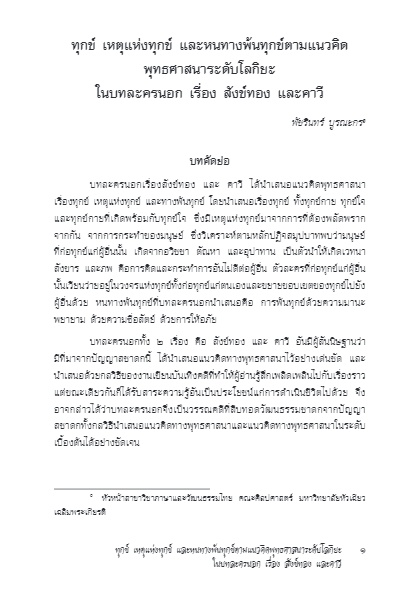พัชรินทร์ บูรณะกร
บทคัดย่อ
บทละครนอกเรื่องสังข์ทอง และ คาวี ได้นำเสนอแนวคิดพุทธศาสนาเรื่องทุกข์ เหตุแห่งทุกข์ และทางพ้นทุกข์ โดยนำเสนอเรื่องทุกข์ ทั้งทุกข์กาย ทุกข์ใจ และทุกข์กายที่เกิดพร้อมกับทุกข์ใจ ซึ่งมีเหตุแห่งทุกข์มาจากการที่ต้องพลัดพรากจากกัน จากการกระทำของมนุษย์ ซึ่งวิเคราะห์ตามหลักปฏิจสมุปบาทพบว่ามนุษย์ที่ก่อทุกข์แก่ผู้อื่นนั้น เกิดจากอวิชชา ตัณหา และอุปาทาน เป็นตัวนำให้เกิดเวทนา สังขาร และภพ คือการคิดและกระทำการอันไม่ดีต่อผู้อื่น ตัวละครที่ก่อทุกข์แก่ผู้อื่นนั้นเวียนว่ายอยู่ในวงจรแห่งทุกข์ทั้งก่อทุกข์แก่ตนเองและขยายขอบเขตของทุกข์ไปยังผู้อื่นด้วย หนทางพ้นทุกข์ที่บทละครนอกนำเสนอคือ การพ้นทุกข์ด้วยความมานะพยายาม ด้วยความซื่อสัตย์ ด้วยการให้อภัย
บทละครนอกทั้ง 2 เรื่อง คือ สังข์ทอง และ คาวี อันมีผู้สันนิษฐานว่ามีที่มาจากปัญญาสชาดกนี้ ได้นำเสนอแนวคิดทางพุทธศาสนาไว้อย่างเด่นชัด และนำเสนอด้วยกลวิธีของงานเขียนบันเทิงคดีที่ทำให้ผู้อ่านรู้สึกเพลิดเพลินไปกับเรื่องราว แต่ขณะเดียวกันก็ได้รับสาระความรู้อันเป็นประโยชน์แก่การดำเนินชีวิตไปด้วย จึงอาจกล่าวได้ว่าบทละครนอกจึงเป็นวรรณคดีที่สืบทอดวัฒนธรรมชาดกจากปัญญาสชาดกทั้งกลวิธีนำเสนอแนวคิดทางพุทธศาสนาและแนวคิดทางพุทธศาสนาในระดับเบื้องต้นได้อย่างชัดเจน
(ตีพิมพ์ใน วารสารไทยศึกษา ปีที่ 10 ฉบับที่ 1 (กุมภาพันธ์ – กรกฎาคม 2557) หน้า 1-25)
Suffering in Buddhism on “Lakhon Nok” story “Sangthong” and “Kawi”
Patcharin Buranakorn
Abstract
The study reveals that “Sangthong” and “Kawi” present the Buddhist dharma of suffering, cause of suffering and the way leading to the end of suffering. They show all types of suffering such as physical suffering, mental suffering and both physical and mental suffering at the same time. The causes of the suffering are the separation from the beloved and human act. According to the doctrine of pratītyasamutpāda, man make other suffered from Avidyā, Vedanā and Upādāna which cause Vedanā, Sangskāras and Bhava. These are bad thought and act toward other. The characters that make other suffered stay in the cycle of sufferings of themselves and extend the suffering to others. In the Lakhon Nok’s play, the way to the end of suffering is to do with effort, faithfulness and forgiveness.
In summary, both “Sangthong” and “Kawi”, which were assumed the origin of Paññāsa Jātaka, present obviously the Buddhist dharma and present with the technique of f iction for the purpose of reader’s entertainment. At the same time, readers also gain the benef icial information for life. Therefore Lakhon Nok is the literature inherits of the Paññāsa Jātaka culture including technique to present Buddhist dharma and primary notion of Buddhism evidently.
(Published in Journal of Thai Studies Volume 10 Number 1 (February – July 2014) Page 1-25)
บทความ / Full Text : Download
